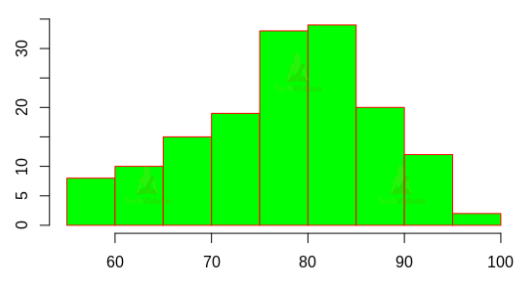how to find class width in statistics
The grade width of a given frequency distribution refers to the length of the course intervals of the distribution. Therefore, form width is indeed the same equally the form size. Some other name for the grade width is the grade length. Form width is calculated by subtracting the lower class limits from the upper-class limits of the frequency distribution.
How to Find the Class Width?
- Place the class intervals of the given distribution.
- Write down the upper and lower limits of each class.
- Subtract the upper limit from the lower in order to obtain the width for that class. This can exist given by the formula below.
Class Width Formula:
\text{Class width} = U - 50 where, U is the upper grade limit and L is the lower class limit of the given class interval.
Example 1:
Using the frequency distribution we tin observe the grade width:
| Marks Obtained | Frequencies |
| 0-ten | seven |
| 10-20 | 3 |
| 20-30 | xv |
| 30-40 | v |
| 40-50 | vii |
| fifty-60 | 9 |
| 60-70 | eight |
The size of the class thirty-40 is the difference between thirty and 40 which is 10. Here we run into that the size of each class is 10. Hence class width for each class in this example is x.
In the above case, the class widths for each grade were equal. It can also be the case that nosotros have unequal course lengths for each class.
Instance 2:
Consider the following frequency distribution table:
| Course Intervals | Frequencies |
| 5-10 | 7 |
| 10-12 | iii |
| 12-fifteen | fifteen |
| 15-25 | 5 |
| 25-45 | 7 |
| 45-l | 9 |
The form width of the class 45-50 is five whereas the grade width of the course 25-45 is 20. Therefore, the class widths are diff in the above example. We compute all of the class widths are follows:
| Form Intervals | Frequencies | Form Width |
| 5-10 | 7 | U-L = 10-five =5 |
| 10-12 | 3 | U-Fifty = 12-10 = 2 |
| 12-15 | 15 | U-L = 15-12 = 3 |
| fifteen-25 | v | U-Fifty = 25 – fifteen = x |
| 25-45 | seven | U-L = 45-25 = 20 |
| 45-50 | 9 | U-L = 50 – 45 =v |
Example three: Class Width for Histogram
If we are given a histogram we tin can compute the class width by looking at the space that each bar occupies on the 10-axis. Consider the histogram given below:

Equally we tin come across in the above histogram, two histograms together occupy a length of ten units on the X-centrality, therefore a unmarried histogram has a width of 5 units. And so based on the above histogram, the class width is v.
Relationship between Class Width and Number of Intervals:
When amalgam a frequency distribution, as the number of classes is decreased, the grade width increases. The reason behind the increase in class length is that more and more values have to be accommodated within a small number of classes. For example, if 100 was partitioned into iv classes, nosotros would have 4 classes each of length 25. But, if 100 was partitioned into 2 classes, nosotros would take 2 classes each of length 50. The size of the class interval is inversely proportional to the number of classes (class intervals) in a given distribution.
Adding Class Width using the Number of Classes:
We can use the given minimum and maximum data entries and the number of classes to detect the course width. For case if we are given that the minimum entry is 20 and the maximum entry is sixty and the number of classes is viii and so we can calculate the class width using the formula, \begin{align*}\text{Class Width}&=\frac{\text{Maximum Entry}-\text{Minimum Entry}}{\text{Number of Classes}}\\ &=\frac{60-twenty}{8} = \frac{40}{eight} = five \end{align*}
Calculating Class Width for Raw Data:
Using the in a higher place formula we know how to determine the class width of tabulated data. But what about raw untabulated data? In that case, we have the following method to calculate the class distribution:
- Observe the range of the information by subtracting the highest and the everyman number of values
- Divide the outcome by the number of classes for the data
Instance:
Suppose we are given the following raw information for marks out of 100 for a class of twenty students:
15, 45, xl, 53, 77, 76, 96, 86, 53, 12, 46, 75, 48, 36, 84, 15, 37, 47, 24, 29
Permit us assume that nosotros want to have 10 classes.
At present Range= Largest value-Smallest value=96-15=81
Therefore Course Width= 81/10=8.1
So we should take the course width to be approximately equal to 8.
How to determine the number of classes for grouped frequency distribution?
In the higher up example, nosotros took the number of classes to be x. But in fact, there exists a formula called Sturges Rule or Sturges formula which states that the number of classes is given as,
\text{Number of classes} = 1+3.322*log_{10}N where, North is the total number of observations.
If we have Northward=100 observations so,
Number of classes=1+three.322*2=7.644, that is, approximately 8.
Further Reading:
- What is the Course Width for a Histogram? (with Examples).
- Class Midpoint/Course Marking.
- Course Width Estimator.
Hey 👋
I'thousand currently pursuing a Ph.D. in Maths. Prior to this, I completed my chief's in Maths & bachelors in Statistics.
I created this website for explaining maths and statistics concepts in the simplest possible fashion.
If you've institute value from reading my content, experience free to support me in even the smallest way you lot can.
Source: https://allthingsstatistics.com/basics/class-width/
Posted by: coatesperis1986.blogspot.com

0 Response to "how to find class width in statistics"
Post a Comment